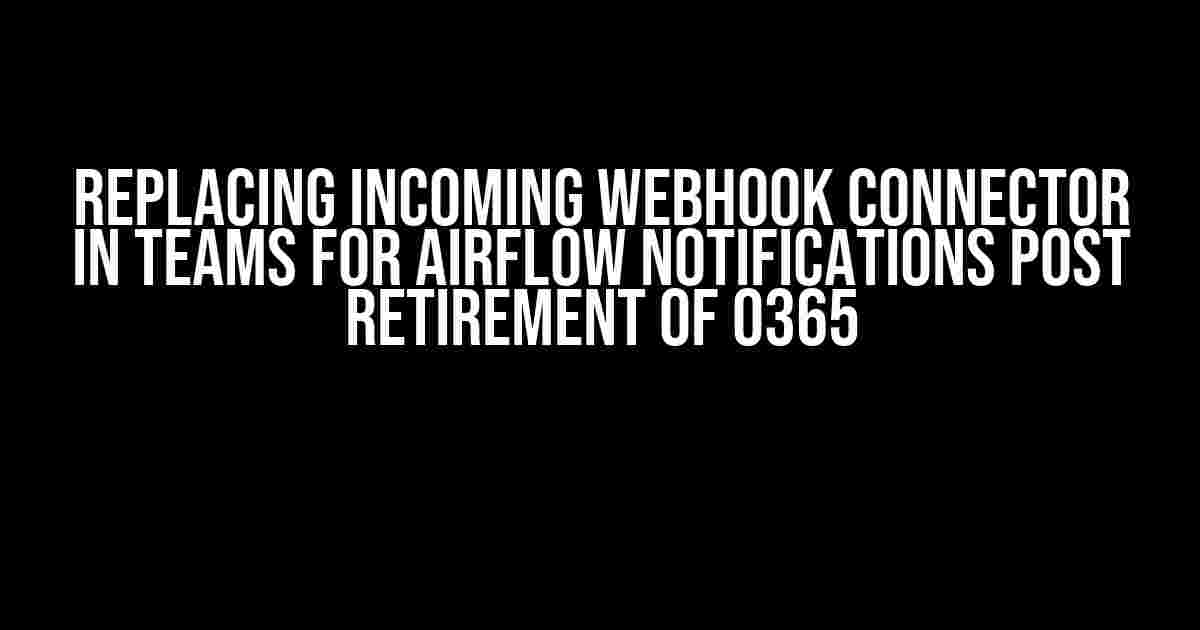Are you tired of scrambling to find a solution to send Airflow notifications to Microsoft Teams after the retirement of O365? You’re not alone! In this article, we’ll guide you through the process of replacing the incoming webhook connector in Teams for Airflow notifications. Buckle up, and let’s get started!
What’s the big deal about O365 retirement?
Microsoft’s decision to retire O365 connectors has left many of us in a pickle. The O365 connector was a convenient way to send notifications from Airflow to Microsoft Teams. Now, we need to find an alternative solution to ensure our teams stay informed about Airflow tasks and workflows.
Why Use a Webhook Connector?
So, why are webhooks the way to go for Airflow notifications in Teams? Here are a few compelling reasons:
- Real-time notifications**: Webhooks enable real-time notifications, ensuring your team stays informed about Airflow tasks and workflows as soon as they happen.
- Customization**: Webhooks provide the flexibility to customize your notifications, allowing you to tailor the content and format to your team’s specific needs.
- Reliability**: Webhooks are a reliable way to send notifications, reducing the likelihood of lost or delayed messages.
Step-by-Step Guide to Replacing the Incoming Webhook Connector
Now that we’ve covered the why, let’s dive into the how. Follow these steps to replace the incoming webhook connector in Teams for Airflow notifications:
Step 1: Create a New Webhook in Microsoft Teams
Log in to your Microsoft Teams account and navigate to the channel where you want to receive Airflow notifications. Click on the “…
+ New connector
Search for “Incoming Webhook” and select the “Incoming Webhook” connector.
Add
Enter a name for your webhook (e.g., “Airflow Notifications”) and upload an image (optional). Click “Add” to create the webhook.
Copy the webhook URL
Copy the generated webhook URL; we’ll need it later.
Step 2: Configure Airflow to Use the New Webhook
Now, let’s configure Airflow to use the new webhook. You’ll need to update your Airflow configuration file (usually `airflow.cfg` or `airflow.yaml`) to include the new webhook URL.
[webhook]
airflow_webhook_url = https://your-webhook-url.com
Replace `https://your-webhook-url.com` with the webhook URL you copied earlier.
Step 3: Set Up Airflow Notifications
Next, we’ll set up Airflow notifications to use the new webhook. You’ll need to create a new notification configuration in your Airflow instance.
from airflow.providers.microsoft.azure/hooks.teams import TeamsWebhookHook
teams_webhook_hook = TeamsWebhookHook(
webhook_conn_id='your-webhook-conn-id',
message='{{ ti.xcom_pull("task_instance_key") }}'
)
default_args = {
'owner': 'airflow',
'depends_on_past': False,
'start_date': days_ago(2),
'retries': 1,
'retry_delay': timedelta(minutes=5),
':on_failure_callback': teams_webhook_hook.notify onFailure
}
Replace `your-webhook-conn-id` with the connection ID of your webhook. You can find this in your Airflow instance under “Admin” > “Connections.”
Step 4: Test Your Webhook Configuration
It’s time to test your webhook configuration! Trigger a task in Airflow, and you should receive a notification in your Microsoft Teams channel.
Trigger a task in Airflow
If everything is set up correctly, you should receive a notification like this:
Task 'your_task_name' has completed successfully!
Common Issues and Troubleshooting
Encountered an issue during the setup process? Don’t worry, we’ve got you covered!
Issue 1: Webhook URL Not Working
If you’re experiencing issues with the webhook URL, try the following:
- Double-check that the webhook URL is correct and copied correctly.
- Ensure that the webhook URL is configured correctly in your Airflow configuration file.
Issue 2: Airflow Notifications Not Working
If Airflow notifications are not working as expected, try the following:
- Verify that the notification configuration is correct in your Airflow instance.
- Check the Airflow logs for any errors or issues related to the webhook.
Conclusion
Replacing the incoming webhook connector in Teams for Airflow notifications might seem like a daunting task, but with these step-by-step instructions, you should be up and running in no time. Remember to test your webhook configuration and troubleshoot any issues that may arise.
By following this guide, you’ll ensure that your team receives timely and informative Airflow notifications, keeping everyone informed and productive.
| Before You Go |
|---|
|
Happy Airflow-ing and Teams-ing!
Frequently Asked Questions
Microsoft’s decision to retire Office 365 (O365) connectors has left many wondering what’s next for their incoming webhook connectors in Teams. Worry not, dear Airflow users! We’ve got the scoop on what you need to know.
What’s happening to my O365 connectors in Teams?
Microsoft is retiring the O365 connectors in Teams, which means you’ll need to find alternative solutions to maintain your incoming webhook connections. Don’t panic, though! You can still use your webhooks with Airflow – we’ll show you how.
Why do I need to replace my O365 connectors in Teams?
Microsoft’s decision to retire O365 connectors means that any existing connections will eventually cease to function. Replacing them ensures that your Airflow notifications continue to flow smoothly and your team stays informed.
What are my options for replacing the O365 connector in Teams?
You have several alternatives, including using third-party connectors, creating custom webhooks, or leveraging other collaboration tools like Slack or Discord. We’ll explore these options in more detail to help you choose the best fit for your team.
How do I configure my new webhook connector in Airflow?
Fear not, young Airflow user! We’ll walk you through the step-by-step process of setting up your new webhook connector. From creating a custom webhook to configuring notification settings, we’ve got you covered.
What kind of support can I expect during this transition?
You’re not alone in this journey! Our team is here to provide guidance, resources, and support every step of the way. From troubleshooting to optimization, we’ll ensure a seamless transition to your new webhook connector.
